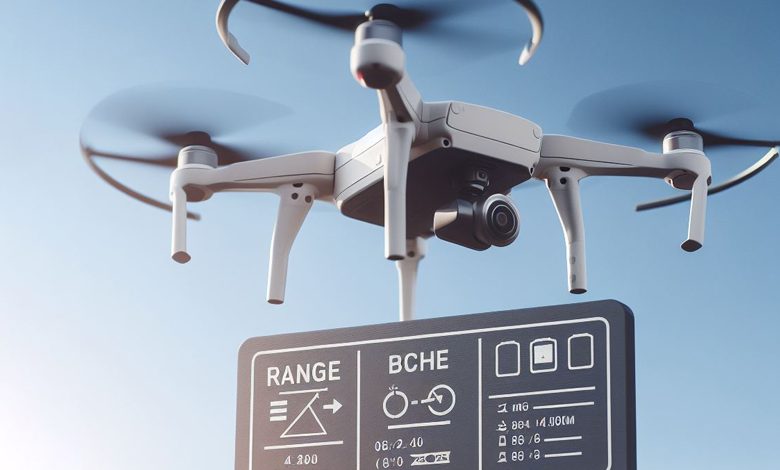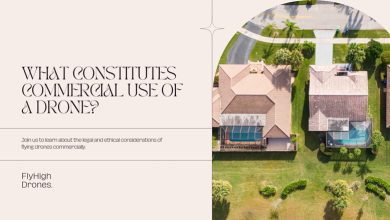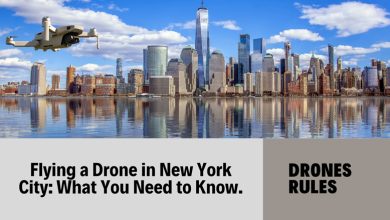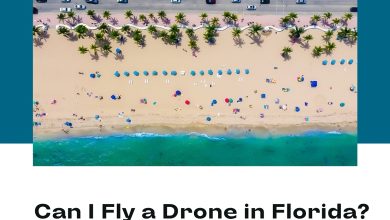What is The Range of a Drone?

As drone technology continues to scale to new heights, understanding how drones operate has become a necessity for enthusiasts and professionals alike
Do you want to know the maximum range of your drone?
In this article, “What is The Range of a Drone,” we want to explore the factors that affect a drone’s ability to fly.
So, let’s get started together!
What is the range of drones?
The range of a drone is the maximum distance it can travel from its controller before losing connection.
However, the range is not set for all drones, and it varies based on numerous factors.
In the following section, we will determine some of the key factors that can affect the range of your drone.
So, stay with us!
Which factors can impact a drone’s range?
Knowing the factors that affect a drone’s range is practical for drone owners and professionals seeking to maximize their aircraft’s capabilities.
These factors can be influenced by various conditions, ranging from environmental to technical specifications.

Below, you can find some of the most important ones:
1. Terrain & Obstacles
The physical obstacles in the drone’s flight path can have a substantial impact on its range. Mountains, buildings, and dense vegetation can obstruct signals and limit how far the drone can travel from the controller.
2. Weather conditions
Weather elements such as wind, rain, and temperature play a pivotal role in a drone’s range. Strong winds can impede forward motion and consume more battery power, while rain or extreme cold can affect the drone’s components and signal strength.
3. Signal strength
The quality and strength of the signal between the controller and the drone are critical factors. Interference from other electronic devices, crowded Wi-Fi channels, or physical barriers can weaken the signal and reduce the drone’s effective range.
4. Battery capacity
We can definitely say that it may depend on the drone’s battery capacity and health! Larger and more healthy batteries provide extended flight times, allowing the drone to cover more distance.
5. Weight & payload
The weight of the drone itself and any additional payload it carries impact its range. Heavier drones or payloads require more power to lift, which can limit the distance they can travel.
6. Controller range
The controller’s range also plays a role in determining how far a drone can travel. Some controllers have longer signal ranges than others, which can extend the drone’s operational radius.
7. Drone design and materials:
The drone’s design and the materials used in its construction impact its overall weight and aerodynamics. Lightweight, aerodynamic drones tend to have better range capabilities.
8. Technical specifications:
Each drone model has unique technical specifications, including the type of communication technology used and the power of its motors. These specifications affect the drone’s ability to maintain a connection and travel a specific distance from the controller.
Admin suggestion: Do I Need a License to Fly a Drone?
What are the tips to increase a drone’s range?
Enhancing the range of your drone can open up new horizons for exploration and aerial photography.
While each drone has its limitations, there are several effective strategies to extend its range:
Choose the right environment
Selecting an optimal flying environment is crucial. Fly in open areas with minimal interference from buildings, trees, or electronic devices. This reduces signal interference and allows your drone to cover more distance.
Upgrade antennas
Upgrading the antennas on both the drone and the controller can significantly improve signal strength and range. High-gain antennas or signal boosters can extend your drone’s reach, ensuring a stable connection.
Fly in ideal weather conditions.
Favor calm weather conditions for extended flights. Strong winds can drain your drone’s battery quickly and reduce its range. Flying during mild weather with minimal wind is ideal for maximizing range.
Monitor battery health
Regularly check and maintain your drone’s batteries. Well-maintained batteries provide consistent power and longer flight times. Ensure your batteries are fully charged before each flight.
Optimize flight settings
Adjust your drone’s flight settings to conserve battery power. Reduce the drone’s speed and fly at a lower altitude when covering long distances. This minimizes power consumption, extending the range.
Use efficient flight paths
Plan efficient flight paths to cover more ground with less energy. Avoid unnecessary maneuvers and keep a straight course whenever possible.
Employ signal boosters
Signal boosters or range extenders can amplify the signal between your controller and the drone. These devices can significantly increase your drone’s range, especially in challenging environments.
Keep the line of sight
Always keep your drone within your line of sight. Flying beyond your visual range can result in signal loss and accidents. Always ensure you can see your drone while flying.
Monitor signal strength
Continuously monitor the signal strength and quality on your controller’s screen. If you notice a weak signal, adjust your drone’s position or altitude to improve reception.
read more:
What Are the Problems of Drones in Agriculture?
Can You Bring a Drone on a Cruise?
What is The Headless Mode on a Drone?
What are the benefits of having a long drone range?
The benefits of having a long drone range are numerous, making it a desirable feature for drone lovers.
Here is why an extended range of a drone can significantly enhance your drone experience:
- Aerial exploration
With a long drone range, you can explore vast areas, from scenic landscapes to remote locations.
- Enhanced photography & videography
A longer range means more opportunities for stunning aerial photography and videography. Capture unique angles, landscapes, and wildlife from greater distances.
- Improved connectivity
Extended range often comes with stronger signal connectivity. This means a more stable and reliable connection between your drone and remote controller, reducing the risk of signal loss.
- Increased efficiency
Professionals can benefit from extended drone range when conducting tasks like surveying, mapping, and monitoring.
- Search & rescue operations
In critical situations, a long drone range can be a lifesaver. Search and rescue teams can use drones to cover expansive areas quickly, improving their chances of locating missing persons or assessing disaster-stricken areas.
- Wildlife observation
For wildlife enthusiasts and researchers, a long drone range allows for unobtrusive observation of animals in their natural habitat without disturbing them.
- Agricultural applications
In agriculture, drones with extended ranges can efficiently monitor and manage large fields, providing valuable data on crop health and irrigation needs.
- Remote inspections
Industrial sectors, such as infrastructure and energy, can benefit from extended drone range for remote inspections of hard-to-reach structures and facilities.
- Sporting events & entertainment
Capture dynamic moments at sporting events and outdoor concerts with a drone that can cover the entire venue without relocating.
- Emergency response
Drones with longer ranges can quickly assess disaster-stricken areas, helping emergency responders make informed decisions and allocate resources effectively.
To what high is it legal to fly a drone?
The legality of how high you can fly a drone is subject to regulations set by aviation authorities in your region, such as the Federal Aviation Administration (FAA) in the United States.
In the U.S., recreational drone operators are generally limited to a maximum altitude of 400 feet above ground level (AGL).
Fly at or below 400 feet in Class G (uncontrolled) airspace.
Note: Anyone flying a drone in the U.S. National Airspace System (NAS) is responsible for flying within the FAA guidelines and regulations.
This altitude restriction is in place to ensure the safety of both human-crewed and unmanned aircraft, as flying drones too high can pose collision risks with other airspace users.
However, there are exceptions to this rule, such as obtaining special waivers for specific operations that require flights above 400 feet AGL.
Drone enthusiasts must familiarize themselves with their country’s drone regulations and abide by the specified altitude limits to ensure safe and lawful drone operations.
So, violating these regulations can result in fines and legal consequences.
Wrap it up
In conclusion, determining the range of a drone is essential for safe and effective operation. Various factors, from battery capacity to environmental conditions, influence how far a drone can fly.
What is The Range of a Drone in your region, and how do you make the most of it in your drone operations? Share your insights in the comments below!




